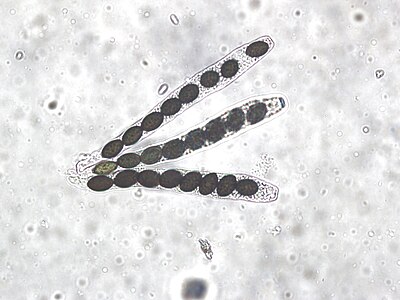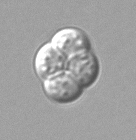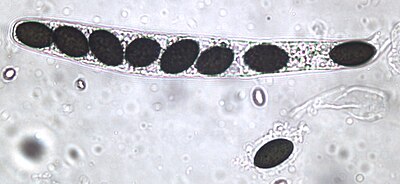Ascus
This article needs additional citations for verification. (June 2015) |

An ascus (from
Typically, a single ascus will contain eight ascospores (or octad). The eight spores are produced by
In many cases the asci are formed in a regular layer, the hymenium, in a fruiting body which is visible to the naked eye, here called an ascocarp or ascoma. In other cases, such as single-celled yeasts, no such structures are found. In rare cases asci of some genera can regularly develop inside older discharged asci one after another, e.g. Dipodascus.
Asci normally release their spores by bursting at the tip, but they may also digest themselves, passively releasing the ascospores either in a liquid or as a dry powder. Discharging asci usually have a specially differentiated tip, either a pore or an operculum. In some hymenium forming genera, when one ascus bursts, it can trigger the bursting of many other asci in the ascocarp resulting in a massive discharge visible as a cloud of spores – the phenomenon called "puffing". This is an example of
Asci, notably those of Neurospora crassa, have been used in laboratories for studying the process of meiosis, because the four cells produced by meiosis line up in regular order. By modifying genes coding for spore color and nutritional requirements, the biologist can study crossing over and other phenomena. The formation of asci and their use in genetic analysis are described in detail in Neurospora crassa.
Asci of most
Classification

The form of the ascus, the capsule which contains the sexual spores, is important for classification of the Ascomycota. There are four basic types of ascus.
- A unitunicate-operculate ascus has a "lid", the morels. 'Unitunicate' means 'single-walled'.
- Instead of an operculum, a unitunicate-inoperculate ascus has an elastic ring that functions like a perithecia; an example is the illustrated Hypomyces chrysospermus.

- A bitunicate ascus is enclosed in a double wall. This consists of a thin, brittle outer shell and a thick elastic inner wall. When the spores are mature, the shell splits open so that the inner wall can take up water. As a consequence this begins to extend with its spores until it protrudes above the rest of the ascocarp so that the spores can escape into free air without being obstructed by the bulk of the fruiting body. Bitunicate asci occur only in pseudothecia and are found only in the classes Dothideomycetes and Chaetothyriomycetes (which were formerly united in the old class Loculoascomycetes). Examples: Venturia inaequalis (apple scab) and Guignardia aesculi (Brown Leaf Mold of Horse Chestnut).
- Prototunicate asci are mostly spherical in shape and have no mechanism for forcible dispersal. The mature ascus wall dissolves allowing the spores to escape, or it is broken open by other influences, such as animals. Asci of this type can be found both in cleistothecia, for instance with Dutch elm disease(Ophiostoma). This is something of a catch-all term for cases which do not fit into the other three ascus types, and they probably belong to several independent groups which evolved separately from unitunicate asci.
Ascospores

An ascospore is a
The ascospores of
The fungi Saccharomyces produces ascospores when grown on V-8 medium, acetate ascospore agar, or Gorodkowa medium. These ascospores are globose and located in asci. Each ascus contains one to four ascospores. The asci do not rupture at maturity. Ascospores are stained with Kinyoun stain and ascospore stain. When stained with Gram stain, ascospores are gram-negative while vegetative cells are gram-positive.
The fission yeast Schizosaccharomyces pombe is a single-celled haploid organism that reproduces asexually by mitosis and fission. However, exposure to the DNA damaging agent hydrogen peroxide induces pair-wise mating of haploid cells of opposite mating type to form transient diploid cells that then undergo meiosis to form asci, each with four ascospores.[4] The production of viable ascospores depends on successful recombinational repair during meiosis.[5] When this repair is defective a quality control mechanism prevents germination of damaged ascospores. These findings suggest that mating followed by meiosis is an adaptation for repairing DNA damage in the parental haploid cells in order to allow production of viable progeny ascospores.
References
- Perseus Project.
- ISBN 978-1-4757-9290-4.
- ^ PMID 28705398.
- PMID 2703462.
- PMID 24312672.
